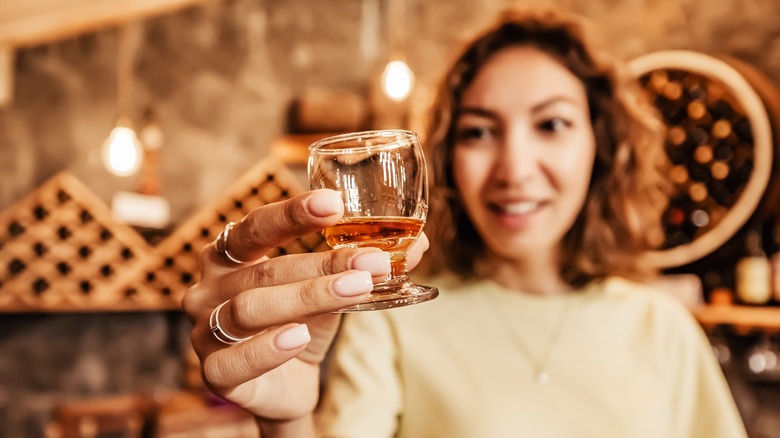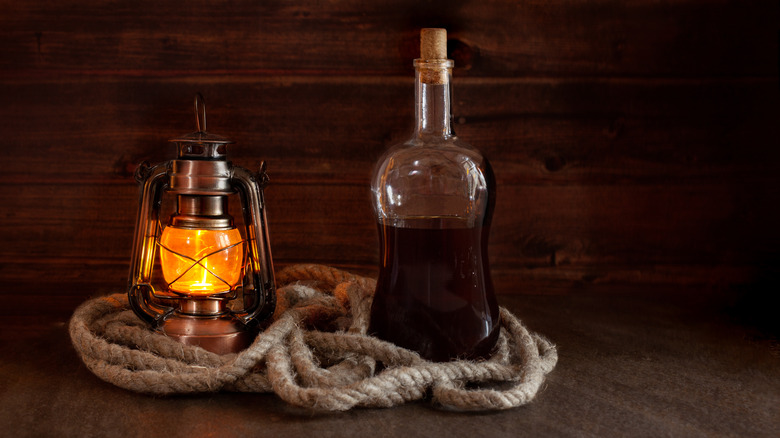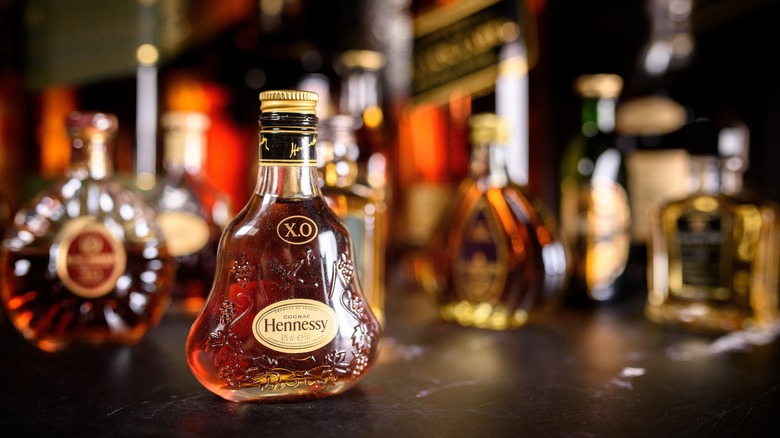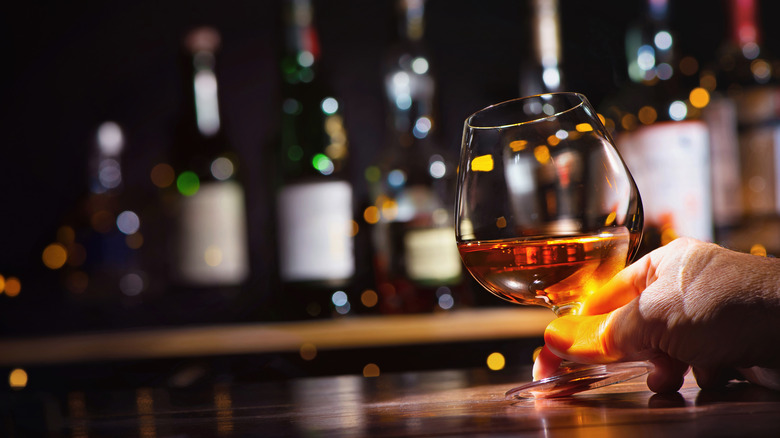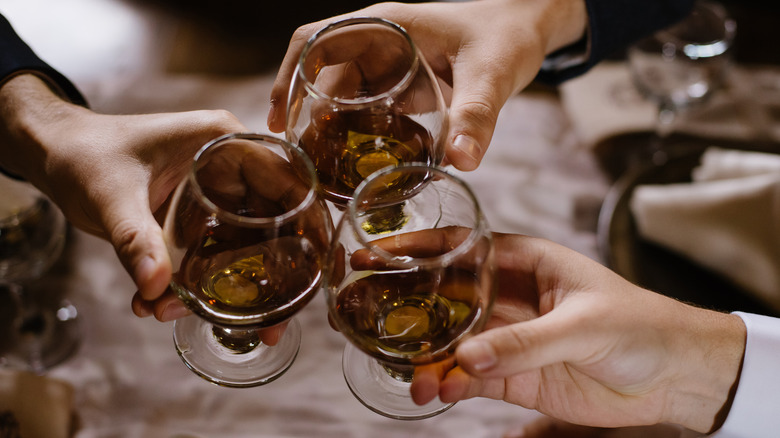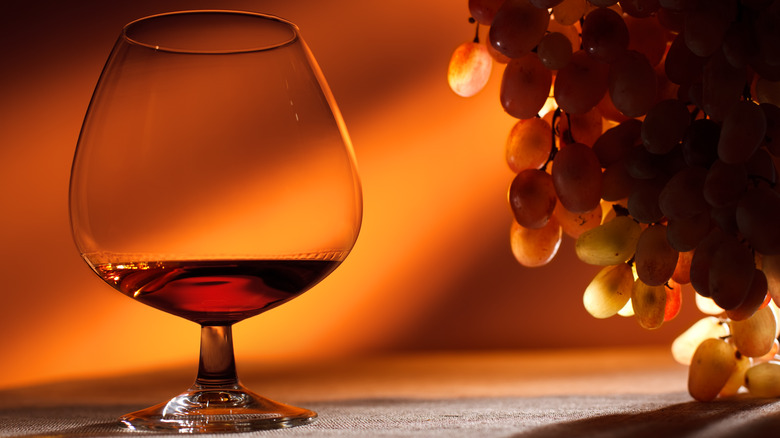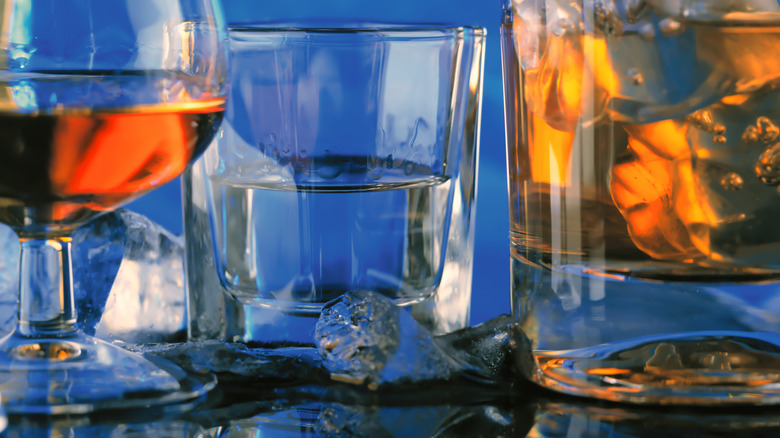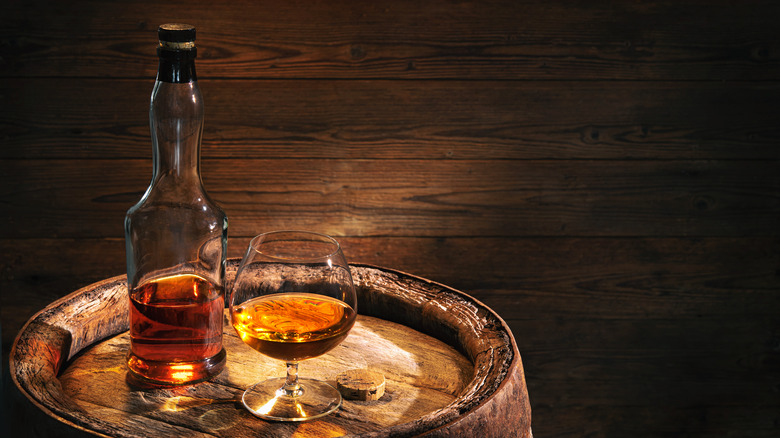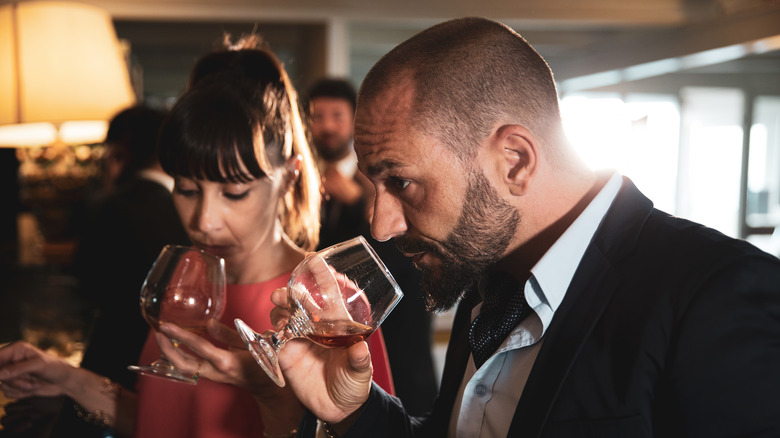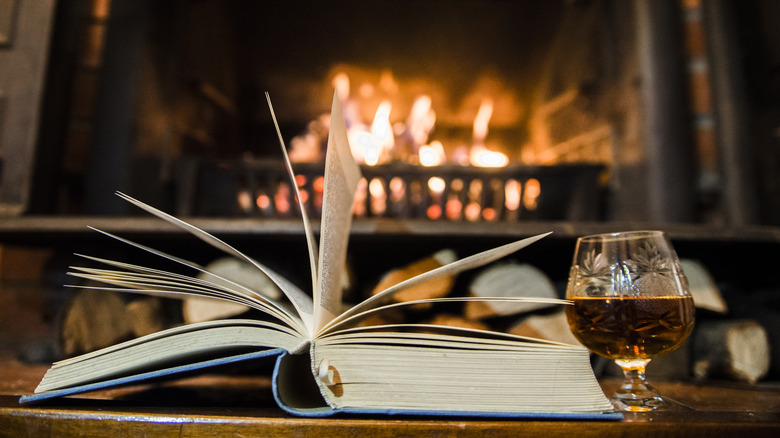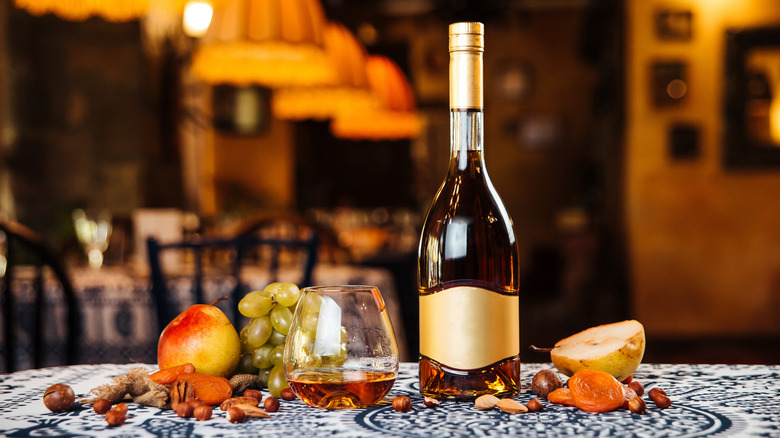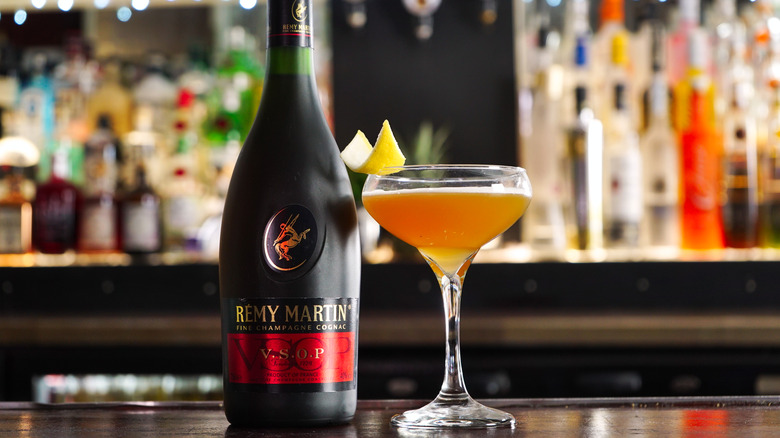How To Drink Brandy Like A True Connoisseur
Brandy is a spirit that can be both a homely tipple and a connoisseur's passion. On the bottom shelf, it's a punchy addition to desserts. The top shelf, however, offers aficionados endless opportunities for enjoyment, exploration, and inspiration.
At its simplest, brandy is a spirit distilled from fermented fruit. Think wine, given the whiskey treatment. By developing your understanding of the key factors that influence its flavor, texture, color, and production, you can learn how to drink brandy like a true connoisseur. A healthy working knowledge of brandy's history, traditions, and the nuts and bolts of connoisseurship is also essential when taking your appreciation of the spirit to the next level.
Having worked as a brand ambassador and marketer in spirits for several years, I've run my fair share of training sessions and masterclasses. Several questions always arise when people want to level up their experience with their drink of choice. There's a lot to learn in the historic world of brandy, but a straightforward guide can turn a casual sipper into a genuine connoisseur.
Learn about global brandy styles
The first essential piece of knowledge for the budding brandy connoisseur is its origins. Brandy first emerged in the Middle Ages as a medicinal liquid. Although France is the country of origin for the spirit, its name is in fact Dutch. From the Dutch term brandewijn — meaning burnt wine — the word brandy was derived as we recognize it today. The burning referred to the practice of boiling wine to reduce its volume on ships, in essence distilling it.
Eventually, the rest of Europe caught on, sparking their own brandy distilling traditions in regions like Spain, with Brandy de Jerez, and the Balkan region's rakia. Grappa, the oft-misunderstood Italian version of brandy, is a notable style that is quickly gaining appreciation. Not surprisingly, regions known for producing quality wine also make great brandy producers.
Among all the world's types of brandy, even the New World has its own traditions. Peru has pisco, the U.S. produces apple-based applejack, and South Africa is also a region with a love of brandy. Despite the far-reaching growth of global brandy production, France is still the top producer of the world's most famous brandies, notably from Armagnac and Cognac.
Consider how production affects taste
The most fundamental characteristic of brandy is its base spirit, specifically, the fermented fruit from which it's distilled. The vast majority of brandies are distilled from fermented grapes, but it can be made from almost any sugar-dense fruit. Non-grape brandies are distilled from fruit wine, cider, or fermented fruit mash, and must be labeled as fruit brandies. Unaged, these can be labeled as eau de vie, meaning water of life.
Common fruits for brandies to be made from are apples (like France's calvados and applejack in the U.S.), pears, cherries, and plums. These each present characteristics of their base fruit, reflecting and concentrating its flavor and aromas.
Distillers can also choose between types of still, most commonly column or copper pot stills. Column stills provide for a continual distillation of spirits, while copper pots offer a more traditional batch-based process. The latter technique results in many flavor compounds remaining intact throughout the distillation, while column stills can produce a more neutral flavor profile. Multiple distillations can further refine a spirit's flavor and texture.
As with wine, the time that brandy spends in barrels has a profound effect on its flavor, as does the type of oak used. The longer a brandy rests in oak barrels, the more it can mellow in flavor, darken in color, and absorb the wood's toasty, nutty, or spicy notes. French oak barrels lend elegant characteristics of honey, vanilla, and nuts. American oak barrels can provide bolder influences, such as notes of tobacco, coconut, or cocoa.
Get familiar with top shelf brandy
It's widely regarded that the world's finest brandy comes from France, specifically the regions of Armagnac and Cognac, which produce famous spirits bearing those names. These brandies adhere to strict laws of production. The production of Cognac and Armagnac brandies align with local restrictions and regulations. A French brandy with AOC on the label — standing for Appellation d'Origine Contrôlée, or controlled designation of origin — means that it complies with all conditions required to be classified as an official product of that region. The grape varieties from which a brandy is made, the time it spends resting in oak, and the type of still used are all aspects that must comply with this legal designation. What this means for the budding connoisseur is that when you talk about cognac and armagnac, you're not just talking about varieties of brandy, but a product that has to meet a series of requirements to qualify.
Other types of top-shelf brandy from outside of cognac and armagnac include France's apple brandy, calvados, which has its very own AOC designation for the Normandy region. South Africa and Spain also produce grape brandies that are right at home on a connoisseur's top shelf — these are complex yet refined, while benefiting from their respective regions' unique wine- and brandy-production history.
Consider stocking a variety of brandies in your home bar
One of the more enjoyable ways to continue refining your palate is by keeping a wide variety of brandies from a range of categories. With a well-stocked home bar, you can revisit, compare, and reconsider your brandies in relation to each other. By regularly observing the intricate differences between the textures, colors, aromas, and flavors your brandies express, you can learn through experience. This can also help to sharpen your palate and expand your appreciation of the spirit over time.
For a home bar with prestige, include at least one or two of the best cognac brands in your lineup. Hennessy is a recognizable brand that offers affordable entry-level mainstays of many connoisseurs' home bars. Martell and Rémy Martin's X.O. selections are highly refined top-shelf bottles for those special occasions. For armagnac, the Darroze brand produces both introductory brandies, such as the eight-year-old Les Grands Assemblages, and prestigious brandies that reach into thousands of dollars in value.
Peruvian piscos and Italian grappas can add variety to the lineup of regional grape brandies in a connoisseur's repertoire. Connoisseurs of brandy may also keep types outside of the grape brandy family. For example, keeping calvados and applejack brandy in stock can represent apple brandies in your cabinet.
Understand the most appropriate occasions for brandy
While there isn't necessarily a single time or place for brandy, there are certain situations that suit this spirit in particular. Some of the best occasions for brandy are those that give it a moment to shine. For example, brandy is a popular aperitif to stimulate your taste buds and prepare the stomach to digest. Its rich flavor and higher alcohol content (typically around 40% to 50% alcohol by volume, or ABV) also make it excellent at resetting the palate.
Brandy may not be such a good idea while enjoying foods that are spicy or high in temperature. The higher volume of alcohol that makes this spirit so rewarding pre- or post-meal can also become fiery in conjunction with such foods.
For gift-giving occasions, brandy can be an auspicious offering or an elegant gesture. Significant events — such as weddings or milestone birthdays — can be suitable times to gift someone a special bottle of cognac or armagnac.
Serve your brandy in snifters or balloon glasses
Discussion of brandy connoisseurs evokes images of sophisticated individuals swirling brandy around wide, tulip-shaped glasses with short stems resting in the palms of their hands. These glasses are known as snifters or brandy balloons. There are several reasons why these glasses enhance the brandy experience, and why they've become the preferred way to enjoy the spirit. The wide diameter of brandy snifters allows more surface area of the brandy to be exposed to air. This creates more opportunity for the liquid's volatile aromas to evaporate, so they can be inhaled. The tapered-in rim keeps these aromatic compounds within the glass, making this tulip shape highly effective at freeing aromas from the liquid, but not from the vessel. A typical serve is 1.5 ounces.
Experienced aficionados know that swirling the brandy also serves a purpose. Coating the walls of the glass creates another opportunity to evaporate more liquid and express more of the brandy's aromas. Placing the bowl of the glass in the palm of your hand helps to keep it close to body temperature, which better allows these volatile compounds to be expressed from the liquid.
Conversely, Italian grappa is typically served in a small glass, with a long stem, and a narrow bowl that tapers in before widening to the rim. This design directs and concentrates the aromas while preventing the drinker's hand from altering the liquid's temperature.
Dilute your brandy with water, not ice
A well-established principle known to Scotch connoisseurs is that a little dilution can go a long way. This same concept relates to how to drink brandy. Just a small amount of water can help to open a spirit up and reveal some of the flavors and aromas that may otherwise be masked by the liquid's alcohol, especially in libations with higher ABV levels.
Although the image of spirits sipped indulgently over ice is a popular one, this can actually make investigating and appreciating a fine brandy harder. Ice serves to cool the brandy and suppress some of the aromatics. Ice can also provide more dilution than is necessary, as most spirits only benefit from a small quantity of water to start opening up. Over-dilution can cause a brandy to taste too watered down.
The ideal temperature for allowing a brandy to express its finest qualities is around room temperature. If the brandy is below this temperature and cool to the touch, you can create contact between the palm of your hand and the bottom of the balloon glass to warm the liquid.
Store your brandy in a cool, dry, dark environment
It's one thing to collect and enjoy a range of fine, diverse, or interesting brandies, but storing them is a skill all true connoisseurs require. Correct storage of brandy, whether expensive or not, means keeping them in ideal condition for as long as possible.
Light exposure can damage spirits over time, so it's important to choose somewhere dark to store your brandy. Similarly, heat can negatively affect the quality of brandy, so finding somewhere cool (but not excessively cold) to store your liquid gold is equally essential. Ensure that the temperature in your chosen storage site is consistent, never rising or falling too drastically or rapidly.
Dampness can also be a bottle's enemy and can compromise its seal, as well as its label. A moldy label can also certainly be a bad look for a connoisseur's top-shelf cognac. Putting thought into the conditions of your brandy's storage can mean maintaining the spirit's integrity, so you can enjoy it for longer. In general, the qualities that make for an effective wine cellar can also help you preserve your brandies.
Keep your nose out of the glass when sniffing
Those entering the world of brandy from a wine background may be tempted to plunge their noses into the depths of their glass and take a deep whiff. This can be a critical mistake, as the higher alcohol in spirits can scorch your sinuses and prevent you from smelling much at all. Brandy balloons are designed to allow this alcohol to evaporate and fill the air in a glass. Taking too generous a sniff of this air can be highly unpleasant and prevent you from smelling much after you burn your nose.
Sniffing brandy from above the rim allows you to get a mix of fresh air and aromatic vapors from your brandy. This can help you identify particular notes and interrogate the aromatic profile of your brandy without excessive intensity. If the aroma inside your glass seems to be diminishing, an artful swish of the glass can coat the sides with more aromatic liquid that can then evaporate.
Sip brandy without swishing in your mouth
Knowing how to drink brandy like a connoisseur means knowing how to taste spirits. Wine aficionados are characteristically known for slurping air through gurgling mouthfuls. This technique draws air through the wine, at once aerating the liquid and allowing aromas and flavors to enter the back palate and sinuses for a fuller, more comprehensive experience. With spirits, however, doing this creates a fiery sensation throughout the mouth, hindering the taster's ability to perceive flavor and texture while scorching the sinuses.
To taste brandy as effectively as possible, you can still use air to enhance the flavor and aroma of the liquid, but differently than wine connoisseurs do. Start by taking a sip of brandy about the size of a teaspoon. Without opening your mouth or letting any air in, move the liquid around the entirety of your mouth, allowing it to coat every corner. Your saliva will begin to dilute the brandy and break up its oils. Start investigating the tasting notes that emerge. Consider what fruits you can taste. Try to discern flavors from the oak, such as vanilla or coconut.
Finally, swallow before breathing in through your mouth and out through your nose. You should experience a burst of flavor as the air that rushes into your sinuses carries aromatic vapor to your olfactory receptors. Now engaging the full power of your sense of smell in conjunction with your taste buds, analyze any notes you can detect in the brandy.
Develop your brandy vocabulary
Drinking brandy like a true connoisseur means being able to talk like one. There are several terms that relate specifically to brandy that can help you speak the language of this storied spirit.
In the world of cognac and armagnac, there are several initialisms that relate to the age of the brandy in the bottle. V.S. stands for "very special" and means that the youngest brandy to join the blend has been aged for at least two years. VSOP, or "very superior old pale," means a cognac comprises a blend of brandies all at least four years old. X.O. stands for "extra old" and means that the brandy is at least 10 years old.
When discussing brandy, understanding key terms shared with other products, such as wine and whiskey, can help you communicate like an aficionado. The term vintage relates to the year in which grapes are harvested, implying that the particular conditions of that year influence the flavor of the fruit and its subsequent brandy. The varietal of a brandy means the type of grape used, such as ugni blanc or folle blanche. As with whiskey, a brandy's age refers to the time spent in the barrel, excluding any time since bottling.
Find the most delicious food pairings
Brandy is generous with flavor, making it an exciting tipple with which to pair food. Identifying the tastiest pairings can help elevate your experience of the brandy you drink by finding foods that highlight the beverage's shining qualities.
Higher alcohol content means that food high in fat creates a rewarding contrast, as brandy's alcohol cuts through and balances out pairings like cheese or cured meats. Creamy cheeses such as Brie or Camembert also pair spectacularly with almost any brandy. For blue cheese lovers, brandy's perceived sweetness and power make it a delicious match against the cheese's strong, earthy flavor. This is especially true for brandies with heightened fruity characteristics.
Some pairings work by way of complementing each other, such as using fresh fruit to match some brandies' riper notes. Soak pears in brandy for a fruity twist on your cocktail or dessert, while a little splash goes a long way in fruit pies and desserts like trifles.
Experimentation is the best way to discover pairings that resonate with your preferences. These can be old-school pairings, such as fine cigars, or more contemporary accompaniments, like types of chocolate.
Make cocktails that highlight the brandy
While the aim of the connoisseur is usually to experience the product in its fullest expression, this doesn't mean that you can't have some fun with brandy-based cocktails. Choosing cocktails that place brandy as the star of the show is actually a great way to appreciate the particular qualities of the spirit.
A brandy Alexander, for instance, is a sweet, creamy cocktail that makes brandy's own perceived sweetness and richness shine. You can even try a frozen brandy Alexander to add panache to this dessert cocktail. The classic sidecar cocktail made with cognac plays off its citrusy notes, and is a great pre- or post-dinner libation for impressing guests.
Consider the key qualities that brandy shares with other spirits to find fun substitutions with which to experiment. For example, cognac's oak influence makes it an exciting substitution in a whiskey-based cocktail, such as an old fashioned or a Sazerac.
